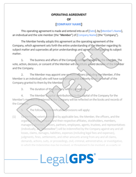Client Release and Liability Waivers: The Ultimate Guide for Your Business
Setting up your business is a remarkable achievement. However, as every entrepreneur knows, running a successful venture is about more than just...
5 min read
LegalGPS : Jul. 25, 2024
Have you ever wanted to organize a drive-and-ride event but were deterred by the potential risks, liabilities, and legal implications? Or maybe you've participated in such an event where you had to sign some document before you could join the fun, and you wondered what it was all about. This post aims to demystify the document you encountered, the 'Release of Liability and Waiver of Rights,' specifically for drive and ride events.


Secure Liability with a Release and Waiver!
Legal GPS templates are drafted by top startup attorneys and are fully customizable🛠️.
Trusted by 1000+ businesses to close secure deals.
The Release of Liability and Waiver of Rights—sometimes referred to simply as a "waiver"— is a legal document that essentially releases an organizer from being sued if a participant gets injured during an event. In the context of drive and ride events, these can be anything from car races, bike tours, to charity marathons. Having such documentation is essential because even though you've taken all the necessary precautions, accidents can still occur.
Imagine a situation where a participant is injured during an event, and he or she sues you for damages. Even though you've done your best to keep participants safe and informed about the risks involved, it's still up to them to take responsibility for their actions. In order to protect yourself from legal action by participants, having a waiver document can help reduce the chances that someone will sue you if something goes wrong.
By nature, drive and ride events involve a certain level of risk. A participant could get into an accident while racing, a bike might malfunction during a ride, or someone could get hit by a car during a city marathon. When such unfortunate incidents occur, the event organizers could potentially be held liable for the injuries or damages.
And this is where the Release of Liability and Waiver of Rights comes in. When a participant signs this contract, they are agreeing to assume the risks involved in taking part in the event. By signing, they also waive their right to sue the event organizer if anything goes wrong.
While it's not a foolproof shield against lawsuits (certain circumstances might still lead to legal action), the presence of this signed agreement could mitigate the chances and potentially limit the liability should a lawsuit occur.
A robust and legal Release of Liability and Waiver of Rights document should have key elements, including:
Party Identification: This includes the names of the event organizer and participant, establishing the stakeholders in the agreement.
Event Description: Details of the event—in this case, the drive or ride event—should be explicitly stated.
Risk Acknowledgement: The document should clearly describe the risks associated with the event and affirm that the participant acknowledges and accepts these risks.
Legal Waiver: This is the critical part wherein the participant waives their right to sue or hold the organizer liable for any injuries, damages, or losses experienced during the event.
Signature Boxes: Both parties should sign the document to make it legally enforceable.
Media Consent and Release Form Essentials
Here's a much more detailed, step-by-step guide on how you can draft your very own Release of Liability and Waiver of Rights.
The first step is identifying who this agreement is between. You will want to include your business name (let's say your business is 'Drive and Fun Enterprise') or your name (say, 'John Smith') in case you’re an individual, and leave space for the participant's full name.
Here's how it might look:
This Agreement is made BETWEEN:Drive and Fun Enterprise, of 123 St, City, State, Country, (the ‘Event Organizer’)AND[PARTICIPANT’S FULL NAME], of [PARTICIPANT'S ADDRESS], (the ‘Participant’)Next, paint a clear picture of the event. Mention the date, location, and a brief description of the event. This helps contextualize the agreement and makes it specific to this event.
Example:
This Agreement is in relation to the Drive and Fun Event scheduled for [DATE] at [LOCATION]. This event is a charitable rally race in which participants will drive their own vehicles along a specified route within a set time frame.


Legal GPS Pro
Protect your business with our complete legal subscription service, designed by top startup attorneys.
Your waiver document should list all possible risks related to the event. The aim is to ensure the participant is aware of each risk they are undertaking.
Example:
The Participant acknowledges that the Drive and Fun Event may involve risks and hazards, including but not limited to: - Accidents or collisions resulting from high speeds, - Danger from other participants or spectators, - Weather conditions, - Equipment failure, - Personal health incidents.State clearly that by signing the document, the participant forfeits the right to sue or place liability on the organizer for any misfortune.
Example:
By signing this document, the Participant hereby releases, waives, discharges, and covenants not to sue the Event Organizer from all liability, claims, demands, losses, or damages caused or alleged to be caused in whole or in part by the negligence of the Event Organizer.Reiterate that the participant fully reads and understands the document before signing. This helps to ensure that they are not signing under any form of duress.
Example:
The Participant has carefully read this Agreement, fully understands its terms and conditions, understands that they are giving up substantial rights by signing it, and signs freely and voluntarily without any inducement.Once written, have a lawyer or legal expert review your document. While drafting the document is a significant step, legal advice can highlight areas that may not be enforceable and ensure compliance with local laws.
Get Your Release of Liability and Waiver of Rights Template
with a Legal GPS Subscription
At the end of the document, include a section where both the participant and the organizer can sign and date.
Example:
Participant's Signature: ____________________ Date: ____________Event Organizer's Signature: ____________________ Date: ____________By adhering to these steps, you will have drafted a comprehensive Release of Liability and Waiver of Rights agreement. Remember that each event and its risks are unique. Consider seeking a legal professional's advice to review your crafted agreement to ensure its protection scope. This article is suggestive and does not serve as legal advice.
In your endeavor to draft this contract, try to avoid the following mistakes:
Not being specific about risks: If a risk is not mentioned in the contract, the participant might have a valid argument that they didn't know about it and thus didn't assume it.
Complicated language: Keep the language clear and straightforward to ensure the participant fully understands what they're agreeing to.
By understanding and deploying a well-crafted Release of Liability and Waiver of Rights for your drive and ride event, you can focus on the logistics and enjoyment of the event without worrying much about legal repercussions. And while the waiver might not fully guarantee that you won't be sued, it can significantly lower the risks and potential liability.
We hope this guide proved helpful. And for those looking to get a head start on drafting their waiver, we have a comprehensive, easy-to-use template prepared by legal experts ready for download and use. Visit our contract template page to secure your template now and make your event planning a smoother experience.

Secure Liability with a Release and Waiver!
Legal GPS templates are drafted by top startup attorneys and are fully customizable🛠️.
Trusted by 1000+ businesses to close secure deals.
The biggest question now is, "Do I need a business lawyer?” For most businesses and in most cases, you don't need a lawyer to start your business. Instead, many business owners rely on Legal GPS Pro to help with legal issues.
Legal GPS Pro is your All-In-One Legal Toolkit for Businesses. Developed by top startup attorneys, Pro gives you access to 100+ expertly crafted templates including operating agreements, NDAs, and service agreements, and an interactive platform. All designed to protect your company and set it up for lasting success.
Get Legal GPS's Release of Liability and Waiver of Rights Template Now

Legal GPS Pro
Protect your business with our complete legal subscription service, designed by top startup attorneys.
| Premium Template Single-use Template |
Legal GPS Pro Unlimited Access, Best Value |
|
|
| Get Template | Learn More |
| Trusted by 1000+ businesses | |

Setting up your business is a remarkable achievement. However, as every entrepreneur knows, running a successful venture is about more than just...

Ever wondered how you can protect your business from potential legal claims brought by employees? If so, you've likely come across terms like...

If you're a personal trainer or involved within the fitness industry, you know that maintaining a strong reputation and offering a seamless service...